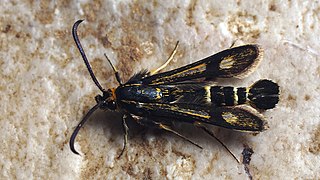
Chamaesphecia empiformis is a moth of the family Sesiidae.

Chamaesphecia tenthrediniformis is a moth of the family Sesiidae.
Chamaesphecia mysiniformis is a moth of the family Sesiidae. It is native to the Iberian Peninsula, southern France, and northern Morocco, but has been introduced to Victoria, Australia in 1997.

Chamaesphecia is a genus of moths in the family Sesiidae.

Chamaesphecia crassicornis is a moth of the family Sesiidae. It is found in south-eastern Austria, southern Slovakia, Hungary, Serbia, Romania, Bulgaria, southern Russia, Kazakhstan and Kyrgyzstan. It is rare in central Europe. It has been released in North America for the biological control of leafy spurge.
Chamaesphecia andrianony is a moth of the family Sesiidae. It is known from Africa.
Chamaesphecia clathrata is a moth of the family Sesiidae. It is known from the Democratic Republic of the Congo.
Chamaesphecia lemur is a moth of the family Sesiidae. It is known from Madagascar.
Chamaesphecia seyrigi is a moth of the family Sesiidae. It is known from Madagascar.
Chamaesphecia anatolica is a moth of the family Sesiidae. It is found in Turkey, Greece, Serbia and Montenegro, Romania and Hungary.
Chamaesphecia aerifrons is a moth of the family Sesiidae. It is found in Morocco, Algeria, Tunisia, Spain, Portugal, France, southern Belgium, south-western Germany, Italy, Sicily, Dalmatia, the Republic of Macedonia, Albania, northern Greece and on Crete, Sardinia and Corsica.
Chamaesphecia albiventris is a moth of the family Sesiidae. It is found in Bulgaria, Greece and Asia Minor.

Chamaesphecia bibioniformis is a moth of the family Sesiidae. It is found in southern Europe and from Asia Minor to Kyrgyzstan.

Chamaesphecia chalciformis is a moth of the family Sesiidae. It is found in Italy, Austria, Slovakia, the Balkan Peninsula, Ukraine, Russia, Turkey, the Middle East and northern Iran.
Chamaesphecia doleriformis is a moth of the family Sesiidae. It is found in Italy, Austria, the Czech Republic, Slovakia, the Balkan Peninsula, Ukraine, Russia and Turkey.
Chamaesphecia euceraeformis is a moth of the family Sesiidae. It is found from Spain and France through Italy and south-eastern Europe to the Caucasus.

Chamaesphecia masariformis is a moth of the family Sesiidae. It is found in south-eastern Europe, Turkey, northern Iran, the Middle East, the Caucasus, southern Russia, Uzbekistan and Tajikistan.

Chamaesphecia nigrifrons is a moth of the family Sesiidae. It is found in central and south-eastern France, Corsica, Luxembourg, South Belgium, south-western Germany, Austria, south-eastern Czech Republic, eastern Slovakia, Hungary, Croatia, Slovenia, former Yugoslavia, Serbia, southern Republic of Macedonia, Bosnia and Herzegovina, Bulgaria, northern Romania, northern Greece, southern Ukraine, Transcaucasia, north-western and southern Turkey and north-western Syria.
Chamaesphecia palustris is a moth of the family Sesiidae. It is found in France, Italy, Austria, the Czech Republic, Slovakia, Hungary, Croatia, Serbia and Montenegro, Romania, Moldova, Ukraine, Russia and northern Turkey.
Chamaesphecia schmidtiiformis is a moth of the family Sesiidae. It is found in Italy, the Balkan Peninsula and Ukraine. It is also found from Turkey to the Black Sea coast, the Caucasus, Turkmenistan and Iran.







